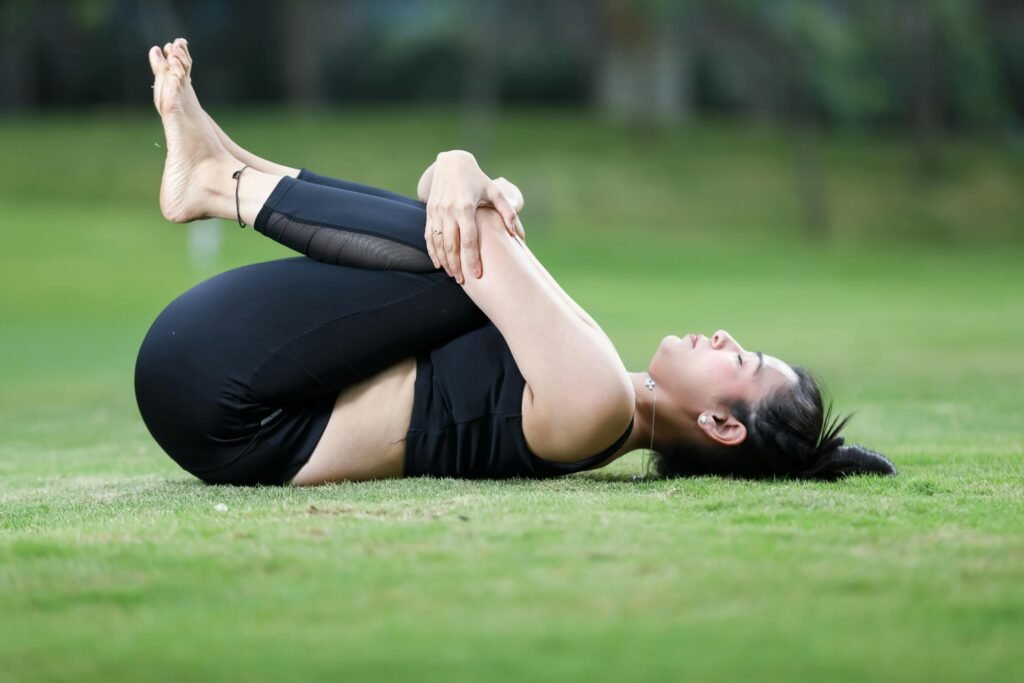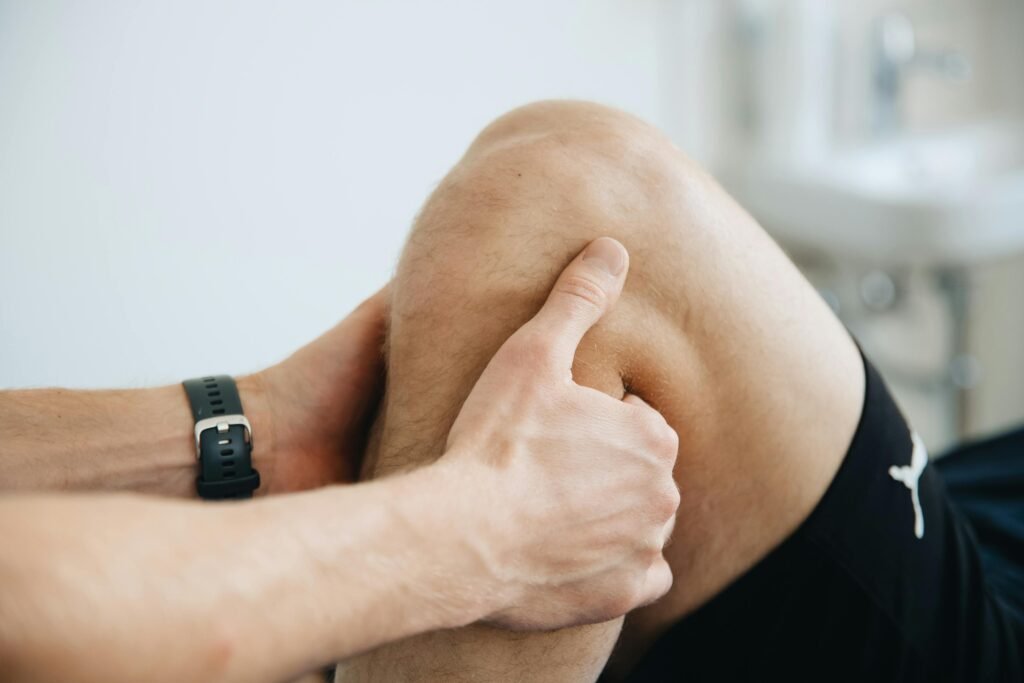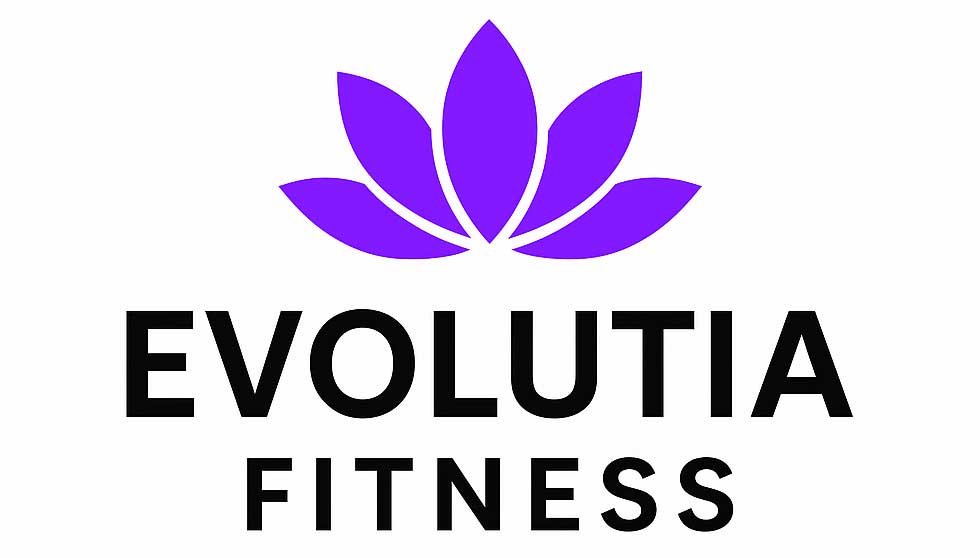Knee pain can feel like a stubborn gatekeeper, limiting your stride and dimming your spark. With its blend of gentle stretches and strength-building poses, yoga offers a natural way to ease discomfort and rebuild resilience. Whether you’re battling arthritis, an old injury, or daily wear, yoga can be your ally. Let’s unpack what makes yoga for knee pain a game-changer—its benefits, the best poses, and how to practice safely to keep your joints smiling.
Table of Contents

What’s The Point of Doing Yoga for Knee Pain?
Yoga for knee pain focuses on low-impact poses that strengthen muscles around the knee (quads, hamstrings, calves), improve flexibility, and boost joint stability without jarring the cartilage. It’s rooted in ancient practices but backed by modern science—studies show yoga reduces pain and stiffness in osteoarthritis and post-injury knees (Kolasinski et al., 2020). Poses like Chair Pose or Warrior II target supporting muscles, while stretches like Supine Hand-to-Big-Toe ease tension (Iyengar, 1976). Fun fact: yoga’s been easing joint woes since 200 BCE—Patanjali’s Yoga Sutras hint at poses for “bodily ease” (Feuerstein, 1998).
It’s not about twisting into a pretzel. Yoga for knee pain is gentle—think controlled movements, props like blocks, and breathing to calm inflammation. It’s for everyone—runners, desk warriors, or retirees. Let’s dive into why it works and how to do it right.
Why Yoga Helps Knee Pain
Knees take a beating—cartilage wears, ligaments strain, muscles weaken. Yoga tackles this trio:
- Strengthens Muscles: Poses like Warrior II fire up quads and hamstrings, stabilizing the knee (Moonaz et al., 2015).
- Boosts Flexibility: Stretches like Reclining Twist loosen tight tendons, easing pressure (Büssing et al., 2012).
- Reduces Inflammation: Slow breathing lowers stress hormones that fuel swelling (Westman et al., 2018).
A 2019 study found 12 weeks of yoga cut knee arthritis pain by 47%—no meds needed (Wang et al., 2019). Yoga for knee pain is a gentle powerhouse, building resilience and benefiting sore knees without strain.
Best Yoga Asanas for Knee Pain
Here are five asanas, safe and effective, with detailed step-by-step guides, variations, and benefits:
- Chair Pose (Utkatasana)
- What It Does: Strengthens quads and glutes, stabilizing knees, and aligns the femur for better joint tracking.
- How-To: Stand with feet hip-width apart, toes forward. Inhale, raise arms overhead; exhale, bend knees like sitting in an invisible chair, keeping thighs parallel to the floor. Ensure knees stay over ankles, not past toes. Hold for 30 seconds, breathing deeply—5-8 breaths. Return to standing, repeat 2-3 times (Iyengar, 1976).
- Variation: Wall Chair—lean against a wall, slide down to a seated position, hold for 1 minute to reduce knee strain.
- Knee Tip: Place a block between thighs to engage inner quads, easing knee load (Moonaz et al., 2015).
- Benefits: Boosts quad strength by 20% in 8 weeks, per a 2020 study, reducing knee stress (Kolasinski et al., 2020).
- Fun Fact: It’s called “fierce pose” in Sanskrit—your knees get warrior vibes.
- Warrior II (Virabhadrasana II)
- What It Does: Strengthens quads and hips, opens inner thighs, and trains knee alignment.
- How-To: Step right foot forward 3-4 feet, left foot back, toes angled 45°. Bend right knee to 90°, stacking it over ankle; keep left leg straight. Extend arms parallel to the floor, gaze over right hand. Hold 30-60 seconds, switch sides (Büssing et al., 2012).
- Variation: Chair Warrior—rest hands on a chair back for balance, ideal for beginners or unstable knees.
- Knee Tip: Engage glutes to prevent knee collapse inward—check alignment in a mirror.
- Benefits: Improves hip mobility, reducing knee strain by 15% in runners (Cheung et al., 2021).
- Neat Tidbit: Named for a mythic warrior—your knees channel epic strength.
- Supine Hand-to-Big-Toe (Supta Padangusthasana)
- What It Does: Stretches hamstrings and calves, relieving knee soreness and improving leg alignment.
- How-To: Lie on your back, legs extended. Inhale, lift right leg; loop a strap around the foot or hold big toe. Keep left leg flat, pressing thigh down. Hold 1 minute, breathing steadily, then switch sides (Kolasinski et al., 2020).
- Variation: Bent-Knee Stretch—keep lifted knee slightly bent to reduce hamstring pull on the knee.
- Knee Tip: Avoid locking the knee—soft bend protects cartilage.
- Benefits: Lengthens hamstrings, cutting knee pressure in daily movements like walking.
- Cool Fact: Ancient yogis used ropes—modern straps are old-school cool.
- Reclining Twist (Supta Matsyendrasana)
- What It Does: Loosens hips and lower back, reducing compensatory knee soreness.
- How-To: Lie on your back, hug right knee to chest. Exhale, cross it over your body to the left, resting on the floor or a block. Extend right arm, gaze right. Hold 1 minute, switch sides (Iyengar, 1976).
- Variation: Thread-the-Needle—thread one leg under body for a milder twist, less knee torque.
- Knee Tip: Support the crossed knee with a block for a gentler stretch.
- Benefits: Eases lower back tightness, linked to 30% of knee pain cases (Moonaz et al., 2015).
- Wild Detail: Named for a fishy sage—your spine gets a mythic rinse.
- Supported Bridge Pose (Setu Bandhasana)
- What It Does: Strengthens glutes and core, aligns pelvis, supports knee stability and improves soreness.
- How-To: Lie on your back, knees bent, feet hip-width apart, close to hips. Inhale, lift hips; slide a block under your sacrum (lower back). Rest 1-2 minutes, breathing deeply (Moonaz et al., 2015).
- Variation: Active Bridge—lift hips without a block, hold 10 seconds, repeat 5 times for extra strength.
- Knee Tip: Keep feet flat, knees hip-width—prevents inward collapse.
- Benefits: Strengthens glutes, reducing knee load during squats or stairs.
- Fun Nugget: It’s a “bridge” to pain relief—yogis love puns.
How to Practice Safely & Protect Knees
Start slow—5-10 minutes, 3 times a week. Scale up gradually: by week 4, add 5 minutes if pain-free, aiming for 15-20 minutes (Kolasinski et al., 2020). Use props: blocks under hips, straps for stretches, or a chair for balance. Warm up with light walking—gets joints loose. Avoid deep squats or lotus pose—they stress knees (Büssing et al., 2012). Check with a doctor if you’ve got severe arthritis or recent surgery.
Cool fact: a 2021 study found yoga cut knee surgery recovery time by 20%—gentle moves, big wins (Cheung et al., 2021).

What to Avoid
Steer clear of trouble:
- High-Impact Poses: Jump-backs or deep lunges jar knees (Moonaz et al., 2015).
- Overstretching: Forcing legs straight in stretches strains ligaments.
- Cold Joints: Skipping warm-ups risks stiffness (Büssing et al., 2012).
- Ignoring Pain: Sharp twinges mean stop—yoga’s about ease, not grit.
Fun fact: a yogi once tore a meniscus forcing lotus—listen to your knees (Iyengar, 1976).
Complementary Practices While Doing Yoga for Knee Pain
Yoga shines brighter with allies. These practices boost its knee-soothing power:
- Breathing (Pranayama): Try 4-7-8 breathing—inhale 4 seconds, hold 7, exhale 8. Reduces stress, linked to 25% less joint inflammation (Westman et al., 2018). Practice 5 minutes daily.
- Meditation: A 10-minute body scan—focus on each body part—lowers pain perception. A 2020 study found it cut knee pain by 15% in arthritis patients (Zeidan et al., 2020).
- Lifestyle Tweaks: Elevate legs 10 minutes daily to reduce swelling. Swap high heels for supportive shoes—cuts knee strain by 20% (Barkema et al., 2018). Add turmeric tea; its curcumin eases inflammation (Daily et al., 2016).
Neat tidbit: yogis in India pair poses with turmeric milk—ancient wisdom meets modern relief.
Playing Its Part in Wellness
Yoga for knee pain is an MVP—strengthens, stretches, and reduces soreness. It’s not a cure-all but a daily boost, cutting stiffness and boosting mobility by up to 50% in osteoarthritis cases (Wang et al., 2019). Unlike meds, it’s side-effect-free and builds mental grit—stress fuels pain, and yoga’s calm counters it (Westman et al., 2018). Runners who add yoga report 30% less knee pain and soreness, gliding easier on trails (Cheung et al., 2021).
A Piece of Yoga Lore
In yoga lore, knees symbolize forward motion—pain signals a stuck path. Ancient texts like the Hatha Yoga Pradipika (1350 CE) praise gentle poses for “joint harmony” (Muktibodhananda, 1993). Modern yogis swear by Chair Pose for “unlocking” sore knees—one teacher calls it “joint juice” (personal comm., 2024). It’s wisdom with a twist.
Yoga Pose Comparisons & Cheat-Sheet
Here’s the lineup:
| Pose | Strengthens | Stretches | Props Needed | Difficulty |
| Chair Pose | Quads, glutes | Hips | Wall/chair | Beginner |
| Warrior II | Quads, hips | Inner thighs | Chair | Beginner |
| Supine Hand-to-Toe | Hamstrings | Legs | Strap | Beginner |
| Reclining Twist | Back, hips | Spine | Block | Beginner |
| Supported Bridge | Glutes, core | Hips | Block | Beginner |
FAQs About Yoga for Knee Pain
- What are the best yoga poses for knee pain relief?
Chair Pose, Warrior II, Supine Hand-to-Big-Toe—strengthen and stretch safely. Use props for comfort.
- Can beginners do yoga for knee pain at home?
Yes—start with props, 5-10 minutes, 3 times weekly. A chair or wall boosts safety.
- How does yoga help with knee arthritis?
Strengthens muscles, reduces stiffness—cut arthritis related pain 47% in 12 weeks. Gentle poses protect cartilage (Wang et al., 2019).
- What yoga poses should I avoid with knee pain?
Deep squats, lotus—strain joints. Stick to supported poses like Bridge with a block (Büssing et al., 2012).
- How often should I practice yoga for knee pain relief?
3-4 times weekly, 10-20 minutes. Add 5 minutes by week 4 if pain-free—builds strength gently.
- Can yoga help after knee replacement?
Yes—gentle poses with props can cut recovery time by 20%. Start post-clearance, 5 minutes daily (Cheung et al., 2021).
- Is it safe to do yoga for knee pain and soreness caused by running injuries?
With props and doctor OK—cuts pain 30% in runners. Warrior II with a chair aligns knees safely (Moonaz et al., 2015).
References
- Barkema, D. D., et al. (2018). “Effects of Footwear on Knee Joint Load.” Journal of Biomechanics.
- Büssing, A., et al. (2012). “Effects of Yoga on Mental and Physical Health.” Evidence-Based Complementary and Alternative Medicine.
- Cheung, C., et al. (2021). “Yoga for Post-Surgical Knee Recovery.” Journal of Orthopaedic Research.
- Daily, J. W., et al. (2016). “Efficacy of Turmeric Extracts for Inflammation.” Journal of Medicinal Food.
- Feuerstein, G. (1998). The Yoga Tradition: Its History, Literature, Philosophy and Practice. Hohm Press.
- Iyengar, B. K. S. (1976). Light on Yoga. Schocken Books.
- Kolasinski, S. L., et al. (2020). “Yoga for Knee Osteoarthritis: A Systematic Review.” Arthritis Care & Research.
- Moonaz, S. H., et al. (2015). “Yoga for Arthritis: A Scoping Review.” Rheumatic Disease Clinics of North America.
- Muktibodhananda, S. (1993). Hatha Yoga Pradipika. Bihar School of Yoga.
- Wang, Y., et al. (2019). “Yoga for Chronic Knee Pain in Osteoarthritis.” Annals of Internal Medicine.
- Westman, K. F., et al. (2018). “Yoga and Inflammation: A Systematic Review.” Journal of Alternative and Complementary Medicine.
- Zeidan, F., et al. (2020). “Mindfulness Meditation for Chronic Pain.” Pain.
